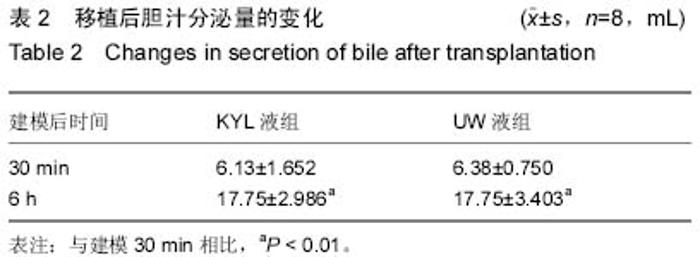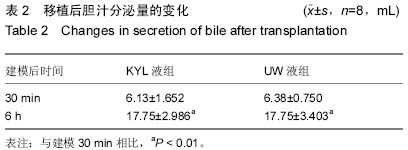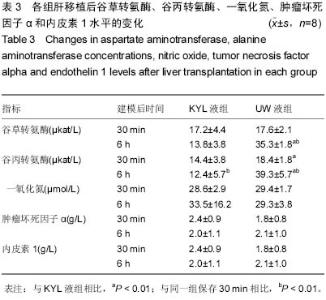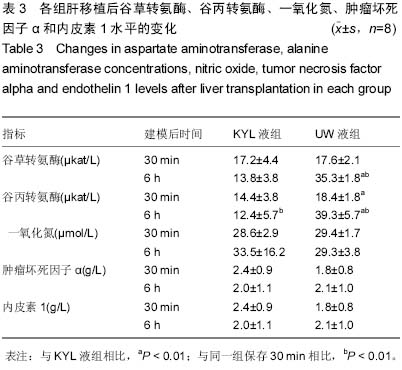| [1] Olschewski P, Hunold G, Eipel C, et al. Improved microcirculation by low-viscosity histidinetryptophan- ketoglutarate graft flush and subsequent cold storage in University of Wisconsin solution: results of an orthotopic rat liver transplantation model. Transpl Int. 2008;21(12):1175- 1180.
[2] Feng L, Zhao N, Yao X, et al. Histidine-tryptophan- ketoglutaratesolution vs. University of Wisconsin solution for liver transplantation: a systematic review. Liver Transpl. 2007; 13(8):1125-1136.
[3] 李晓延,陈刚,白建华,等.恒河猴同种异体原位经典式肝移植模型的建立[J].昆明医学院学报,2008,29(5):72-74.
[4] Belzer FD, southward TH. Principles of solid organ preservation by cold storage. Transplantation. 1988;45(4): 673-676.
[5] 叶辉,张锐敏.HX-3液和UW液保存大鼠肝脏效果的比较[J].中华器官移植杂志,1997,18(1):50.
[6] Eumimoto R, Kamada N, Jamieson NV, et al. A comparison of a new solution Combining histidine and lactobienate with UW solution and eurocouins for rat liver preservation. Transplantation. 1991;51(3):589-593.
[7] 谭晓冬,刘永辉.外源性三磷酸腺苷在大鼠肝脏低温保存中的作用[J].中华器官移植杂志,2001,22(4):235.
[8] Mahmoud MS, Wang P, Chaudry IH. Saluyazy effects of ATP-MgCl2 on altezed hepotocyte signal transduction after chemorrhagic shock. Am J Physiol. 1997(6 Pt 1):G1347- G1354.
[9] Rockey DC, Chung JJ. Reduced nitric oxide production by endothelial Cells in cirrhotic rat liver: endothelial dysfunction in portal hypertension. Gastroenteroloty. 1998;114(2): 344-351.
[10] Serracino-Inglott F, Habib NA, Mathie RT. Hepatic ischemia reperfusion injury. Am J Surg. 2001;181(2):160-166.
[11] Yoshizumi T, Yanaga K, Soejima Y, et al. Amelioration of liver injury by ischemia preconditioning. Br J Surg. 1998;85(12): 1636-1640.
[12] Uhlmann D, Uhlmann S, Spiegel HU. Important role for endothelins in acute hepatic ischemia/reperfusion injury. J Invest Surg. 2001;14(1):31-45.
[13] Ricciardi R, Schaffer BK, Shah SA, et al. Bosentan, an endothelin antagonist, augments hepatic graft function by reducing graft circulatory impairment following ischemia/reperfusion injury. J Gastrointest Surg. 2001;5(3): 322-329.
[14] Colletti LM, Green M. Lung and liver injury following hepatic ischemia reperfusion in the rat is increased by exogenous lipopolysaccharide which also increases hepatic TNF production in vivo and in vitro. Shock. 2001;16(4):312-319.
[15] Aihara T, Shiraishi M, Hiroyasu S, et al. Ulinastatin, a protease inhibitor,attenuates hepatic ischemia reperfusion injury by down-regulating TNF-alpha in the liver. Transplant Proc. 1998;30(7):3732-3734.
[16] Teoh N, Field J, Sutton J, et al. Dual role of tumor necrosis factor-a in hepatic ischemia reperfusion injury: studies in tumor necrosis factor-a gene knockout mice. Hepatology. 2004;39(2):412-421. |





